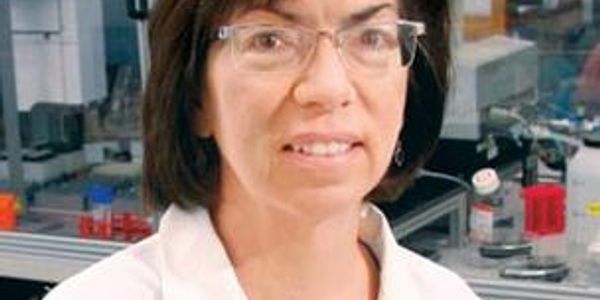Clinical Diagnostics
Clinical Diagnostics: The identification of a disease in regards to a patient's complaints based merely on signs, symptoms, and medical history of the patient rather than on laboratory examination or medical imaging.
-
MAR 20, 2014 | 1:00 PMUsing high throughput next-generation sequencing to simultaneously search large number of genes for pathogenic mutations has numerous advantages. It decreases the pressure to narrow the dif...MAR 20, 2014 | 12:00 PMAlzheimers disease (AD) is a common neurodegenerative disorder characterized clinically by progress decline in memory and thinking and pathologically by the presence of senile plaques and neu...MAR 20, 2014 | 11:00 AMAlzheimers disease (AD) is a neurodegenerative disorder producing cognitive impairment and dementia in millions of elders. Currently no treatment is effective to slow the progression of AD. M...MAR 20, 2014 | 10:00 AMNeuroimaging plays a large role in our pursuit of the understanding of behavior and cognition in health and disease. The past decade has seen the emergence of a wealth of resources that suppo...MAR 20, 2014 | 10:00 AMWith a rising prevalence recently exceeding 1%, autism spectrum disorder (ASD) has become a pressing public health issue. Crucial hurdles on the way to targeted treatments are (i) the relianc...MAR 20, 2014 | 10:00 AMWhen speaking of neurodegenerative diseases, average public is not made aware of the true cost that brain related disorders have on annual budget. The true impact on economy is not usually...MAR 20, 2014 | 9:00 AMThe Brain Research through Advancing Innovative Neurotechnologies (BRAIN) Initiative is part of a new Presidential focus aimed at revolutionizing our understanding of the human brain. By acce...Speaker: Story Landis, PhD, Thomas R. Insel, MD, Justin Sanchez, PhD, John C. WingfieldPresented at: Neuroscience Virtual Event Series 2014
MAR 20, 2014 | 8:00 AMLate onset dementia is usually a multi-factorial disease wherein cumulative pathological brain insults (of more than one pathology) results in progressive cognitive decline which ultimately l...MAR 20, 2014 | 8:00 AM...MAR 20, 2014 | 7:00 AMHuntington's disease (HD) is a progressive, inherited, degenerative brain disorder that produces physical, mental and emotional changes. Named for George Huntington, the physician who fi...MAR 20, 2014 | 7:00 AMThe brain is a complex, densely wired circuit made out of heterogeneous cells, which vary in their shapes, molecular composition, and patterns of connectivity. In order to help discover how n...MAR 20, 2014 | 6:00 AMConnectomics is a new field of research that aims to map the synapses of the nervous system in order to construct a wiring diagram of all the neural circuits. It is necessary to use the elect...MAR 19, 2014 | 1:00 PMThe Willerth lab investigates how to engineer neural tissue by combining pluripotent stem cells, controlled drug delivery and biomaterial scaffolds. When generating these replacement tissues,...MAR 19, 2014 | 1:00 PMATP-binding cassette transporter A1 (ABCA1) mediates cholesterol efflux to lipid-free apolipoproteins such as apolipoprotein A-I (apoA-I) and apolipoprotein E (apoE). ABCA1 is essential regul...MAR 19, 2014 | 12:00 PM...MAR 19, 2014 | 12:00 PMSynaptic dysfunction and loss caused by age-dependent accumulation of synaptotoxic Amyloid beta (Abeta)1-42 oligomers is proposed to underlie cognitive decline in Alzheimers disease (AD). Syn...MAR 19, 2014 | 10:00 AMNeuron-glial interactions are increasingly recognized as being key for physiological and pathological processes in the central nervous system. Microglia have been found to play a causal role...MAR 19, 2014 | 9:00 AMDendritic spine shape enables sequestering of subcellular components needed for synaptic plasticity, including polyribosomes for local protein synthesis, smooth endoplasmic reticulum (SER) to...MAR 19, 2014 | 8:00 AMThe Brain Research through Advancing Innovative Neurotechnologies (BRAIN) Initiative is part of a new Presidential focus aimed at revolutionizing our understanding of the human brain. By...Speaker: Emery N. Brown, MD, PhD, William Newsome, PhD, Justin Sanchez, PhD, Terrence J Sejnowski, PhDPresented at: Neuroscience Virtual Event Series 2014
MAR 19, 2014 | 7:00 AMDown syndrome (DS) is a complex multi-system disorder affecting more than 5.8 million individuals around the world and it causes significant physical, psychological, and cognitive abnormaliti...MAR 19, 2014 | 7:00 AMMultiple Sclerosis (MS) is an autoimmune disease that leads to widespread pathology within the central nervous system (CNS) and is the most common cause of neurologic disability among young a...MAR 19, 2014 | 6:00 AMIn physical systems built with many components, emergent properties, such as magnetism, are often generated from the interactions among these particles. These emergent properties are often in...FEB 19, 2014 | 10:00 AMMaking precision cancer care a future reality requires novel approachesto finding treatment targets in cancers. Single-gene assays currently performed in clinical research laboratories are in...Speaker: Christopher Corless, MD, PhDLaboratory rats and mice are the most used animal species in scientific research, but still having a lot of information available about them, there are many places in Latin America where ther...Speaker: Carolina Mourelle, LATGPresented at: Laboratory Animal Sciences Virtual Event Series 2014
MAR 20, 2014 | 1:00 PM
Using high throughput next-generation sequencing to simultaneously search large number of genes for pathogenic mutations has numerous advantages. It decreases the pressure to narrow the dif...
MAR 20, 2014 | 12:00 PM
Alzheimers disease (AD) is a common neurodegenerative disorder characterized clinically by progress decline in memory and thinking and pathologically by the presence of senile plaques and neu...
MAR 20, 2014 | 11:00 AM
Alzheimers disease (AD) is a neurodegenerative disorder producing cognitive impairment and dementia in millions of elders. Currently no treatment is effective to slow the progression of AD. M...
MAR 20, 2014 | 10:00 AM
Neuroimaging plays a large role in our pursuit of the understanding of behavior and cognition in health and disease. The past decade has seen the emergence of a wealth of resources that suppo...
MAR 20, 2014 | 10:00 AM
With a rising prevalence recently exceeding 1%, autism spectrum disorder (ASD) has become a pressing public health issue. Crucial hurdles on the way to targeted treatments are (i) the relianc...
MAR 20, 2014 | 10:00 AM
When speaking of neurodegenerative diseases, average public is not made aware of the true cost that brain related disorders have on annual budget. The true impact on economy is not usually...
MAR 20, 2014 | 9:00 AM
The Brain Research through Advancing Innovative Neurotechnologies (BRAIN) Initiative is part of a new Presidential focus aimed at revolutionizing our understanding of the human brain. By acce...
Speaker:
Story Landis, PhD, Thomas R. Insel, MD, Justin Sanchez, PhD, John C. Wingfield
Presented at: Neuroscience Virtual Event Series 2014
MAR 20, 2014 | 8:00 AM
Late onset dementia is usually a multi-factorial disease wherein cumulative pathological brain insults (of more than one pathology) results in progressive cognitive decline which ultimately l...
MAR 20, 2014 | 8:00 AM
...
MAR 20, 2014 | 7:00 AM
Huntington's disease (HD) is a progressive, inherited, degenerative brain disorder that produces physical, mental and emotional changes. Named for George Huntington, the physician who fi...
MAR 20, 2014 | 7:00 AM
The brain is a complex, densely wired circuit made out of heterogeneous cells, which vary in their shapes, molecular composition, and patterns of connectivity. In order to help discover how n...
MAR 20, 2014 | 6:00 AM
Connectomics is a new field of research that aims to map the synapses of the nervous system in order to construct a wiring diagram of all the neural circuits. It is necessary to use the elect...
MAR 19, 2014 | 1:00 PM
The Willerth lab investigates how to engineer neural tissue by combining pluripotent stem cells, controlled drug delivery and biomaterial scaffolds. When generating these replacement tissues,...
MAR 19, 2014 | 1:00 PM
ATP-binding cassette transporter A1 (ABCA1) mediates cholesterol efflux to lipid-free apolipoproteins such as apolipoprotein A-I (apoA-I) and apolipoprotein E (apoE). ABCA1 is essential regul...
MAR 19, 2014 | 12:00 PM
...
MAR 19, 2014 | 12:00 PM
Synaptic dysfunction and loss caused by age-dependent accumulation of synaptotoxic Amyloid beta (Abeta)1-42 oligomers is proposed to underlie cognitive decline in Alzheimers disease (AD). Syn...
MAR 19, 2014 | 10:00 AM
Neuron-glial interactions are increasingly recognized as being key for physiological and pathological processes in the central nervous system. Microglia have been found to play a causal role...
MAR 19, 2014 | 9:00 AM
Dendritic spine shape enables sequestering of subcellular components needed for synaptic plasticity, including polyribosomes for local protein synthesis, smooth endoplasmic reticulum (SER) to...
MAR 19, 2014 | 8:00 AM
The Brain Research through Advancing Innovative Neurotechnologies (BRAIN) Initiative is part of a new Presidential focus aimed at revolutionizing our understanding of the human brain. By...
Speaker:
Emery N. Brown, MD, PhD, William Newsome, PhD, Justin Sanchez, PhD, Terrence J Sejnowski, PhD
Presented at: Neuroscience Virtual Event Series 2014
MAR 19, 2014 | 7:00 AM
Down syndrome (DS) is a complex multi-system disorder affecting more than 5.8 million individuals around the world and it causes significant physical, psychological, and cognitive abnormaliti...
MAR 19, 2014 | 7:00 AM
Multiple Sclerosis (MS) is an autoimmune disease that leads to widespread pathology within the central nervous system (CNS) and is the most common cause of neurologic disability among young a...
MAR 19, 2014 | 6:00 AM
In physical systems built with many components, emergent properties, such as magnetism, are often generated from the interactions among these particles. These emergent properties are often in...
FEB 19, 2014 | 10:00 AM
Making precision cancer care a future reality requires novel approachesto finding treatment targets in cancers. Single-gene assays currently performed in clinical research laboratories are in...
Speaker:
Christopher Corless, MD, PhD
Laboratory rats and mice are the most used animal species in scientific research, but still having a lot of information available about them, there are many places in Latin America where ther...
Speaker:
Carolina Mourelle, LATG
Presented at: Laboratory Animal Sciences Virtual Event Series 2014
























